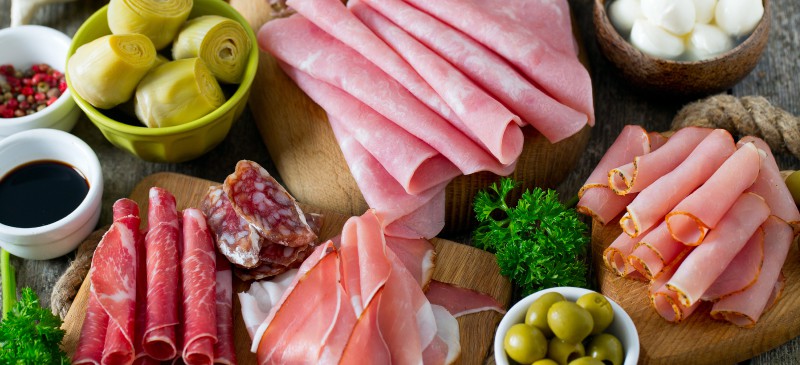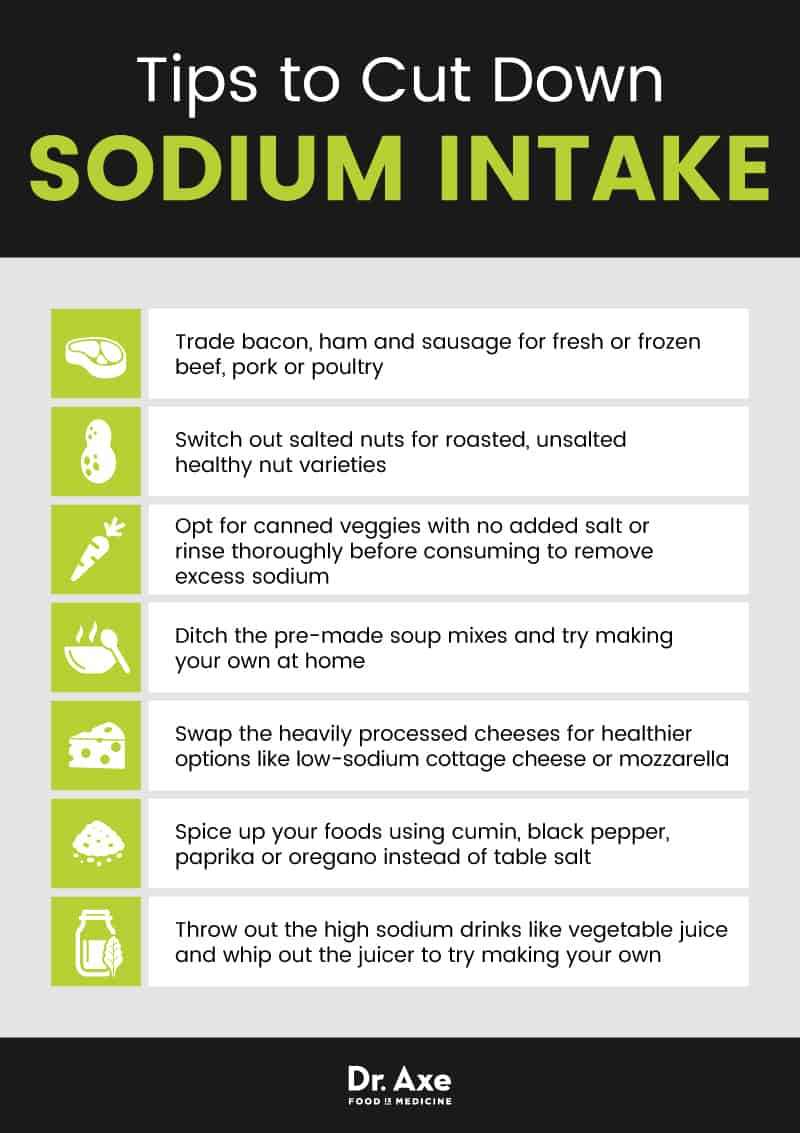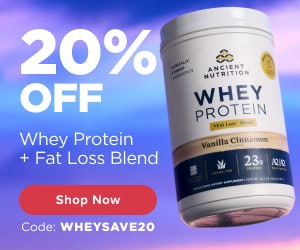Top 10 Foods High in Sodium Americans Consume Too Much
March 19, 2018
Updated: August 13, 2018

Unlike other vitamins and minerals that are present in just a few select sources, sodium is found in abundance throughout the diet. In fact, it’s one of the few micronutrients that doesn’t have a set minimum daily intake but instead has a recommended amount that you should try to stay below. This can make it especially challenging for those trying to limit their intake of foods high in sodium to help reduce blood pressure and improve heart health.
Many Americans eat far too much sodium in the form of processed foods and nutritionally devoid beverages. Interestingly, though, there are some known drawbacks to a diet extremely low in sodium. In fact, the current upper limit to sodium consumption doesn’t mesh with research on the amount of healthy sodium needed for disease prevention and optimal health.
If you’re consuming too much, slashing your sodium intake doesn’t have to be difficult. By making a few healthy swaps in your diet and replacing high-sodium foods with lower-sodium alternatives, it can be simple to keep your sodium consumption in check and enhance your overall health.
If you’re not getting enough, though, there are definitely healthy ways to introduce more sodium into your diet than filling up on processed foods.
What Is Sodium?
Sodium is a mineral that plays an important role in your health. In fact, the body tightly regulates concentrations of sodium, and even minor fluctuations can have a major impact. (1)
Most notably, sodium is involved in muscle contractions. Losing high amounts of sodium and other electrolytes (aka electrolyte imbalance) through the sweat can directly contribute to muscle cramps in athletes, which is why sports beverages are used to replace electrolytes (electrolyte drinks) during intense workouts. (2)
Sodium is also involved in the regulation of blood volume, blood pressure and nerve function, all of which are vital to maintaining overall health. (3, 4)
Low sodium levels in your blood can lead to a condition known as hyponatremia, which results in symptoms like nausea, tension headaches, confusion, fatigue and irritability. In severe cases, it can even lead to seizures and coma. However, hyponatremia is usually caused by sodium losses due to other factors rather than a low sodium intake, such as the use of certain medications, dehydration, severe vomiting or diarrhea, drinking too much water, or changes in hormone levels. (5)
Table salt is one of the most common forms of sodium in the diet. Also known as sodium chloride, table salt is actually composed of about 60 percent chloride and 40 percent sodium. Other salt varieties like pink Himalayan sea salt or kosher salt are also often used.
Sodium is also widely used throughout the food supply. It’s used to cure meats, boost flavor and aid in the preservation of foods. For this reason, a sodium deficiency is pretty rare, and most of us actually get way too much sodium in our diets, increasing the risk of certain conditions that can negatively impact health.
Related: Healthy Salt Substitute Alternatives vs. Unhealthy Options to Avoid
Top 10 Foods High in Sodium
Sodium is found in a variety of food sources. Besides table salt, it’s especially high in processed meats, pre-made sauces and ultra-processed foods. According to the Centers for Disease Control and Prevention (CDC): “More than 40% of the sodium we eat each day comes from only 10 types of food. Many people are surprised to learn which foods are on the list because the foods do not always taste salty.” (6)
What are these top 10 foods high in sodium that we should limit and/or avoid? Here’s what the CDC says:
- Breads and rolls
- Pizza
- Sandwiches
- Cold cuts and cured meats
- Soups
- Burritos and tacos
- Savory snacks, such as chips, popcorn, pretzels, snack mixes and crackers
- Chicken
- Cheese
- Eggs and omelets
Related: What Is Samphire? Surprising Benefits and How to Cook It

Related: Are Potato Chips Good for You? Pros & Cons of This Common Snack (+ Healthy Alternatives)
How Much Sodium Do You Need?
So how much sodium per day should you actually be getting in your diet? According to the American Heart Association, your body only needs about 500 milligrams of sodium per day to function properly. That translates to less than a quarter teaspoon, which is significantly less than most of us eat in a single meal, let alone in a whole day. In fact, the average sodium intake for Americans averages about 3,400 milligrams daily, or nearly seven times the minimum amount that your body needs, according to federal organizations. (7)
The most recent Dietary Guidelines for Americans recommends limiting daily sodium intake to less than 2,300 milligrams per day for adults to minimize the risk of adverse effects on health. (8) Reducing sodium intake to less than 1,500 milligrams can reduce high blood pressure. (9)
While this may seem like quite a big reduction, it can actually be pretty simple by just trading in a few foods high in sodium for low-sodium options instead.
A large epidemiological study in Canada reported that people who consume more than 5,000 milligrams per day of sodium were at an elevated risk of heart disease and stroke. (10) On the other hand, some research points to a range of 8-15 grams of salt per day (1.5-3 tsp/3,200-6,000 milligrams) as a good, heart-healthy range.
The greatest disparity in these numbers is not just the difference in these guidelines; It is the source of sodium that plays a major part in whether or not the salt you consume actually protects you from disease or increases your risk.
Related: Imitation Crab Meat May Be Even Worse Than You Think
Dangers of Too Much Sodium
1. High Blood Pressure
High blood pressure forces the heart to work harder, placing extra strain on the heart muscle. Not only that, but high blood pressure causes damage to your arteries and can also increase the risk of heart disease. Potential risk factors and causes of hypertension include genetics, pre-existing heart conditions and dietary factors.
Sodium, in particular, is involved in the regulation of blood pressure, and reducing your sodium intake is one of the most effective ways to keep it in check. One review comprising 34 studies showed that a moderate decrease in salt intake reduced blood pressure by an average of 4.18 mmHg for systolic blood pressure and 2.06 mmHg for diastolic blood pressure. (11) Another study published in Global Heart also found that cutting down on sodium intake was associated with a significant reduction in blood pressure, especially in those with hypertension. (12)
2. Bone Loss
A high-sodium diet can cause an increase in excretion of calcium through the urine. This can result in bone loss, which can lead to the development of conditions like osteopenia or osteoporosis. (13)
One study published by the Medical Research Council showed that moderately high salt intake increased urinary calcium excretion and negatively impacted calcium balance in the bones among 11 women. (14) Similarly, a review out of Italy reported that a high-sodium diet is linked to high blood pressure, which may increase the risk of bone fractures and osteoporosis. (15)
3. Kidney Disease
High blood pressure, which is often caused by excess sodium consumption, can lead to damage of the small, delicate blood vessels in the kidneys. If the kidneys aren’t functioning properly, they’re unable to properly get rid of sodium, leading to even higher blood pressure and increased kidney damage. (16)
For those with any form of kidney disease, it’s imperative to keep a close eye on sodium intake. Guidelines from the the National Kidney Foundation Kidney Disease Outcomes Quality Initiative recommend that people with chronic kidney disease who are not on dialysis should limit sodium intake to less than 2,400 milligrams daily. For those with kidney failure on hemodialysis, sodium intake should be cut down to just 2,000 milligrams daily. (17)
4. Stomach Cancer
While most people are well aware of the association between sodium intake and high blood pressure, the relationship between salt and stomach cancer is not as widely known.
Salt is believed to increase the growth of Helicobacter pylori (H. pylori), which is a type of bacteria that may be linked to a higher risk of stomach cancer. (18) Shockingly, one review made up of seven studies and over 268,000 people showed that those with a high salt intake had a 68 percent higher risk of stomach cancer than those with a low intake of salt. (19) However, keep in mind that these studies show an association but don’t necessarily account for other possible factors. More research is needed to fully understand the connection between sodium and stomach cancer.
Related: Are Saltine Crackers Healthy? Pros & Cons of Saltines
Dangers of Too Little Sodium
1. Increased Heart Disease Risk
While a low-sodium diet is often heralded as a “must” for reducing the risk of heart disease, the numbers don’t always prove it works that way. Yes, lowering your sodium intake can slightly lower high blood pressure, but it can happen at the cost of rising other heart disease risk factors.
A large meta-analysis reviewed the impact of a low-sodium diet on heart disease risk factors and found that drastic sodium restriction led to an increase in LDL (“bad”) cholesterol without a boost in HDL cholesterol. The same individuals had a 3.6 times increase in renin levels. (20) Renin is an enzyme produced by the kidneys; The higher the amount of renin in your blood, the higher your risk for heart attack is (no matter your blood pressure). (21)
2. Symptoms of Depression
While not thoroughly tested in humans, there is some evidence that drastically reducing your salt intake might induce signs of depression in an animal model. (22)
3. Higher Insulin Resistance
Insulin resistance, a condition present in obese, prediabetic and diabetic individuals, may be worsened when salt is greatly restricted. In the largest study of its kind (and one of the only that includes both men and women), a trial revealed that individuals on high-sodium diets had better insulin sensitivity, while those eating low-salt diets had significantly increased insulin resistance. (23)
Because insulin resistance is correlated with diabetes and heart disease risk, it’s possible that simply lowering your sodium intake to an extreme is not actually beneficial for the heart.
4. Increased Mortality Risk in Diabetes
Although the mechanisms aren’t totally clear, patients with type 2 diabetes symptoms who consume less sodium are at a higher risk of death from heart disease and all-cause mortality (death from any cause). (24) More studies need to be completed to determine whether this is a causative effect.
5. Higher Risk of Falls in the Elderly
Mild but chronic hyponatremia (low sodium levels in the blood) is associated with a higher chance of falls in elderly individuals. It seems that elderly people who consume less salt have more issues with gait and attention while walking. This is of major concern, as these types of falls often result in hospitalization in this at-risk population. (25)
High-Sodium Foods vs. Low-Sodium Foods
Deciphering between foods low in sodium and high-sodium foods is easier than you might think.
As a general rule of thumb, processed meats that have been smoked, cured, salted or canned are generally foods high in sodium and should be limited in the diet. Salty snacks, frozen meals, sauces and canned foods with added salt are also usually high in sodium as well. Conversely, whole foods like fruits and vegetables are naturally low in sodium.
Here are a few simple ways that you can make to quickly cut down on your sodium intake:
- Trade bacon, ham and sausage for fresh or frozen beef, pork or poultry.
- Switch out salted nuts for roasted, unsalted healthy nut varieties.
- Opt for canned veggies with no added salt or rinse thoroughly before consuming to remove excess sodium.
- Ditch the pre-made soup mixes and try making your own at home.
- Swap the heavily processed cheeses for healthier options like low-sodium cottage cheese or mozzarella.
- Spice up your foods using cumin, black pepper, paprika or oregano instead of table salt.
- Throw out the high sodium drinks like vegetable juice and whip out the juicer to try making your own.

Where Sodium Hides
Sodium tends to lurk in some unexpected places beyond the salt shaker. In fact, studies have actually found that processed foods account for 77 percent of the sodium in the average diet. (26)
Processed foods like pre-made entrees, frozen dinners and convenience items are pumped full of sodium to aid in preservation and bump up the flavor. This even applies to canned foods; in fact, even some types of vegetables can be high in sodium when canned. Other high-sodium foods include tomato sauces, packaged vegetable juice, soy sauce, salad dressings, boxed dessert mixes, buttermilk and quick breads.
Sodium is also abundant in fast food as well, with some entrees meeting (and exceeding) the daily limit in a single serving. It’s best to limit eating fast food altogether as there are very few low-sodium fast food options, but you can easily check the nutrition facts of most restaurants online to find the best choices if you’re in a pinch.
Foods High in Sodium Recipes + Healthier Alternatives
As you track sodium intake, one of the most important things you can do is eliminate poor sources of sodium (like those listed above) and getting salt from better sources. Regular table salt is often full of unexpected ingredients such as added iodine, aluminum derivatives and MSG or processed sugar.
Instead, get healthy sodium from these rich sources:
- Sea/pink Himalayan salt (2,300 milligrams per teaspoon)
- Pickles (1,900 milligrams per serving)
- Canned peppers (1,900 milligrams per serving)
- Bone broth (600 milligrams per serving)
- Sauerkraut (400 milligrams per serving)
If you’re concerned about high sodium intake, making a few simple swaps to your favorite high-sodium recipes can transform them into nutritious, low-sodium dishes. Here are a few ideas to get you started:
History
Sodium makes up about 2.6 percent of the Earth’s crust and is considered the sixth most prevalent element on the planet. Still, despite its abundance, sodium is never found on its own in nature. (27)
Salt, however, has been used as a natural remedy throughout history. In medieval times, a compound called sodanum was used as a natural remedy for headaches. Wafers of salt called salarium were also given to Roman soldiers in addition to their normal wages.
Although it has been widely recognized for its potential health-promoting properties for centuries, pure sodium wasn’t isolated until 1807 by scientist Sir Humphry Davy. It was added to the periodic table in 1814 under the abbreviation “Na,” which is short for natron, a compound of sodium that was originally used by Egyptians during the process of embalming.
In recent years, researchers have just begun to understand the complex relationship between sodium intake and health and the multitude of effects that too much — or too little — can have.
Precautions
Although most people should limit their intake of foods high in sodium, some studies have found that a low-sodium diet may be associated with some negative effects on health, as I describe above. For this reason, it’s best to keep sodium intake in moderation rather than attempting to cut it out of the diet altogether.
Additionally, sodium recommendations can differ based on a variety of factors. Competitive athletes and workers who may be exposed to heat stress, for example, should be mindful of their sodium intake and be sure to replete any electrolytes — including sodium — that may be lost through the sweat. People with chronic conditions like kidney disease or heart problems may also have altered sodium needs and should consult with their doctors or dietitians to determine how much sodium they need in their diets.
Finally, when it comes to high blood pressure, getting enough potassium in your diet is just as crucial as limiting your sodium intake. Potassium helps balance out the effects of sodium by relieving tension in the walls of the blood vessels and keeping blood pressure under control. In addition to reducing your intake of foods high in sodium, be sure to incorporate a variety of potassium-rich foods in your diet, such as spinach, avocados and sweet potatoes.
Final Thoughts
- Sodium is an important mineral that is involved in muscle contraction and the regulation of blood pressure, blood volume and nerve function.
- While your body does need some sodium, too much may be associated with an increased risk of high blood pressure, stomach cancer, kidney disease and bone loss.
- For most people, it’s recommended to stay below 2,400 milligrams of sodium per day. Ideally, however, sodium intake should actually be lower than 1,500 milligrams.
- Foods high in sodium include processed meats, canned foods, salty snacks, and frozen or convenience items. Whole, fresh foods, on the other hand, are naturally low-sodium foods.
- Swapping out foods high in sodium with low-sodium alternatives is an easy way to cut down on your sodium intake and help improve your health.

